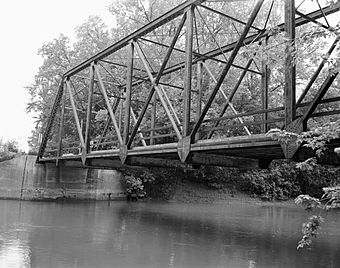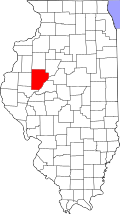Metal Highway Bridges of Fulton County Thematic Resources facts for kids
Quick facts for kids |
|
|
Metal Highway Bridges of Fulton County TR
|
|

The Indian Ford Bridge, one of five demolished Metal Highway Bridges of Fulton County
|
|
| Location | Fulton County, Illinois, USA |
|---|---|
| Nearest city | Ellisville, Lewistown, London Mills, Seville, Smithfield |
| Built | c. 1880-1915 |
| Architect | Various |
| MPS | MPL011 - Metal Highway Bridges of Fulton County Thematic Resources |
| NRHP reference No. | 80001355 - 80001363 |
| Added to NRHP | October 29, 1980 |
The Metal Highway Bridges of Fulton County Thematic Resources is a special list of historic places. It was created for the National Register of Historic Places in Illinois, USA. This list originally included nine different bridges found across Fulton County. However, since these bridges were added to the Register in 1980, more than half of them have been taken down or destroyed.
Contents
Historic Bridges of Fulton County
The nine bridges on this list were all located in quiet, rural areas. They were far from big cities and towns. These bridges were usually found on dirt roads. Most of them could be reached by car, except for one. But remember, many dirt roads in Illinois can become very muddy and hard to drive on when it rains!
The original list included nine steel truss highway bridges in Fulton County. They were built in a very similar way and all crossed the Spoon River. These bridges were near different small communities. They were all officially added to the National Register of Historic Places on October 29, 1980.
The nine bridges first listed were: Seville Bridge, Bernadotte Bridge, Buckeye Bridge, London Mills Bridge, Babylon Bend Bridge, Elrod Bridge, Duncan Mills Bridge, Tartar's Ferry Bridge and Indian Ford Bridge. Sadly, five of these nine bridges have been destroyed since 1980. Four bridges – Tartar's Ferry, Bernadotte, Buckeye, and Elrod – were near Smithfield, Illinois. Only the Bernadotte Bridge is still standing from that group. The Indian Ford Bridge and London Mills Bridge were both near London Mills, Illinois; neither of them exist anymore. The other three bridges – Babylon Bend, Seville, and Duncan Mills – were located near Ellisville, Seville and Lewistown, Illinois. Out of these three, only the Duncan Mills Bridge has been taken down.
Building History of the Bridges
The nine bridges that make up the Metal Highway Bridges of Fulton County were all built between about 1880 and 1915. All of them were, and still are (if they remain), on county and township roads in country areas. They are all very similar in how they were built and what materials were used. These bridges are important because they are early examples of steel truss bridges in Illinois.
How They Were Built
The bridges in Fulton County show two main types of steel truss bridge designs: Pratt and Parker. These were the most common types of steel truss bridges built a long time ago. Because there were slight differences in each bridge type, the collection in Fulton County was special. It offered a unique chance to see how steel truss bridge construction changed from the late 1800s to the early 1900s.
For example, the London Mills Bridge, which was a Pratt type built in 1883 and is now gone, used special "pinned connections." It also had "double eyebars" for its lower parts and diagonal supports. Compare this to the Indian Ford Bridge, also a Pratt type built in 1917 and now destroyed. This bridge used "riveted connections" and "I-beam" construction for its lower parts and diagonal supports. This shows how building methods improved over time.
All the bridges used similar building materials. Each one was almost entirely made of steel. The only possible exceptions were the London Mills Bridge and the Seville Bridge. These two bridges – only the Seville one is still standing – are mostly steel. But they might also have some iron parts because they are so old. The main bottom sections of the bridges ranged from about 140 feet (43 meters) to 200 feet (61 meters) long. Their average width was about 16 feet (5 meters). These bridges looked light, which was typical for metal bridges of that time. However, the later bridges started to look more like modern steel truss bridges.
Why Some Bridges Are Gone
The Elrod Bridge was completely destroyed by a very strong F-4 tornado. This tornado moved through Fulton County during a big storm in 1995.
Why These Bridges Are Important
Together, the nine steel truss bridges were special because they were all so close to each other in Fulton County. They were also historically important because of their age. They showed how early steel truss bridges were built. It is very rare to find so many related historic sites in one small area. When they were first nominated for the National Register of Historic Places in 1980, before some were destroyed, people even took special tours by canoe and car to see them.


